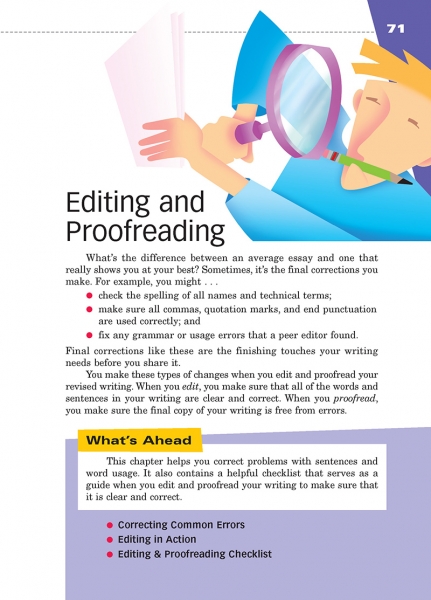Page 071 from

Start-Up Activity
Ask students to raise their hands if they ever wear glasses. Ask those who raise their hands if they've ever gone to a movie only to realize their glasses are dirty and they can't see things the way they would like. Ask them what it's like to wear glasses in the rain. Get them to volunteer stories about losing their glasses, or losing a lens from one side, or breaking their glasses, and the frustration that followed. Point out that the whole reason for glasses is to look through them and focus on something else. When the lenses themselves are dirty or water-speckled or broken or lost, the person can no longer focus on anything else and instead focuses on the glasses.
Then tell your students that writing works the same way. The words and sentences and paragraphs are suppose to focus the reader's attention on ideas. But when the writing is filled with errors in spelling, punctuation, usage, and mechanics, readers stop looking at the ideas and start focusing on the writing itself. The purpose of editing is to clean and polish the words on the page so that readers can look through them to see what the writer is actually thinking.
Think About It
“You can't depend on your eyes when your imagination is out of focus.”
—Mark Twain

Start-Up Activity
Ask students to raise their hands if they ever wear glasses. Ask those who raise their hands if they've ever gone to a movie only to realize their glasses are dirty and they can't see things the way they would like. Ask them what it's like to wear glasses in the rain. Get them to volunteer stories about losing their glasses, or losing a lens from one side, or breaking their glasses, and the frustration that followed. Point out that the whole reason for glasses is to look through them and focus on something else. When the lenses themselves are dirty or water-speckled or broken or lost, the person can no longer focus on anything else and instead focuses on the glasses.
Then tell your students that writing works the same way. The words and sentences and paragraphs are suppose to focus the reader's attention on ideas. But when the writing is filled with errors in spelling, punctuation, usage, and mechanics, readers stop looking at the ideas and start focusing on the writing itself. The purpose of editing is to clean and polish the words on the page so that readers can look through them to see what the writer is actually thinking.
Think About It
“You can't depend on your eyes when your imagination is out of focus.”
—Mark Twain





